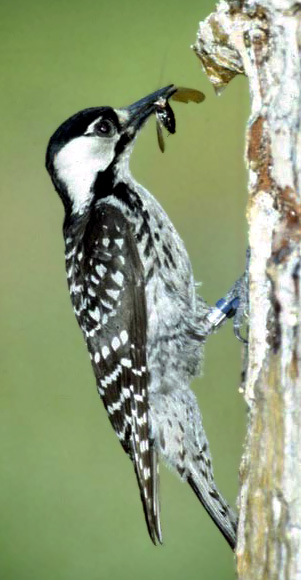Red-cockaded Woodpecker
From Wikipedia, the free encyclopedia
[Photo] Female Red-cockaded Woodpecker. Red-cockaded Woodpecker , Picoides borealis, photograph. Source Retrieved from United States Marine Corps on 7 April, 2006. Original caption: PhotoID: 2005729133853, Submitted by: MCB Camp Lejeune A Red-cockaded Woodpecker takes a cockroach back to his nest. Photograph. Dust on original scanned image cleaned up. Date 22 July 2005. Author Lance Cpl. Matthew K. Hacker, United States Marine Corps
About the size of the Northern Cardinal, the Red-cockaded Woodpecker (Picoides borealis) is approximately 20-22 cm long, with a wingspan of about 35 cm. Its back is barred with black and white horizontal stripes.
The Red-cockaded Woodpecker's most distinguishing feature is a black cap and nape that encircle large white cheek patches. Rarely visible, except perhaps during the breeding season and periods of territorial defense, the male has a small red streak on each side of its black cap called a cockade, hence its name. The Red-cockaded Woodpecker feeds primarily on ants, beetles, cockroaches, caterpillars, wood-boring insects, and spiders, and occasionally fruit and berries.
Reproduction and development
Red-cockaded Woodpeckers are a territorial, nonmigratory, cooperative breeding species, frequently having the same mate for several years.The nesting season lasts from April to June. The breeding female lays three to four eggs in the breeding male's roost cavity. Group members incubate the small white eggs for 10-12 days. Once hatched, the nestlings remain in the nest cavity for about 26 days. Upon fledging, the young often remain with the parents, forming groups of up to nine members, but more typically three to four members. There is only one pair of breeding birds within each group, and they normally only raise a single brood each year. The other group members, called helpers, usually males from the previous breeding season, help incubate the eggs and raise the young. Juvenile females generally leave the group before the next breeding season, in search of solitary male groups.
Range and population level
Historically, this woodpecker's range extended in the southeastern United States from Florida to New Jersey and Maryland, as far west as eastern Texas and Oklahoma, and inland to Missouri, Kentucky, and Tennessee. Today it is estimated that there are about 5,000 groups of red-cockaded woodpeckers, or 12,500 birds, from Florida to Virginia and west to southeast Oklahoma and eastern Texas, representing about 1 % of the woodpecker's original population. They have become extinct-(extirpated), in New Jersey, Maryland, and Missouri.
A map of sightings of the red-cockaded woodpecker in the U.S.A. is in external links below. Sighting maps of individual states, counties etc. can also be generated at this site. In Texas, red-cockaded woodpeckers can be seen at W.G. Jones State Forest (see external link below)
Habitat
The Red-cockaded Woodpecker makes its home in mature pine forests. Longleaf Pines (Pinus palustris) are most commonly preferred, but other species of southern pine are also acceptable. While other woodpeckers bore out cavities in dead trees where the wood is rotten and soft, the Red-cockaded Woodpecker is the only one which excavates cavities exclusively in living pine trees. The older pines favored by the Red-cockaded Woodpecker often suffer from a fungus called red heart rot which attacks the center of the trunk, causing the inner wood, the heartwood, to become soft. Cavities generally take from 1 to 3 years to excavate.
The aggregate of cavity trees is called a cluster and may include 1 to 20 or more cavity trees on 3 to 60 acres (12,000 to 240,000 m²). The average cluster is about 10 acres (40,000 m²). Cavity trees that are being actively used have numerous, small resin wells which exude sap. The birds keep the sap flowing apparently as a cavity defense mechanism against rat snakes and possibly other predators. The typical territory for a group ranges from about 125 to 200 acres (500,000 to 800,000 m²), but observers have reported territories running from a low of around 60 acres (240,000 m²), to an upper extreme of more than 600 acres (2.40 km²). The size of a particular territory is related to both habitat suitability and population density.
The Red-cockaded Woodpecker plays a vital role in the intricate web of life of the southern pine forests. A number of other birds and small mammals use the cavities excavated by Red-cockaded Woodpeckers, such as chickadees, bluebirds, titmice, and several other woodpecker species, including the Downy, Hairy, and Red-bellied Woodpeckers. Larger woodpeckers may take over a Red-cockaded Woodpecker cavity, sometimes enlarging the hole enough to allow Eastern Screech Owls, Wood Ducks, and even Raccoons to move in later. Flying Squirrels, several species of reptiles and amphibians, and insects, primarily bees and wasps, also will use Red-cockaded Woodpecker cavities.
In an effort to increase the Red-cockaded Woodpecker population in sites such as River Creek, the Rolf and Alexandra Kauka Wildlife Management Area, near Thomasville, Georgia, the state is creating artificial cavities in Longleaf Pine trees. Department of Natural Resources staff use two methods. They either carve a wedge from a tree and insert a pre-made wood nesting cavity, or drill a cavity into the tree.
http://en.wikipedia.org/wiki/Red-cockaded_Woodpecker
| The text in this page is based on the copyrighted Wikipedia article shown in above URL. It is used under the GNU Free Documentation License. You may redistribute it, verbatim or modified, providing that you comply with the terms of the GFDL. |
|

